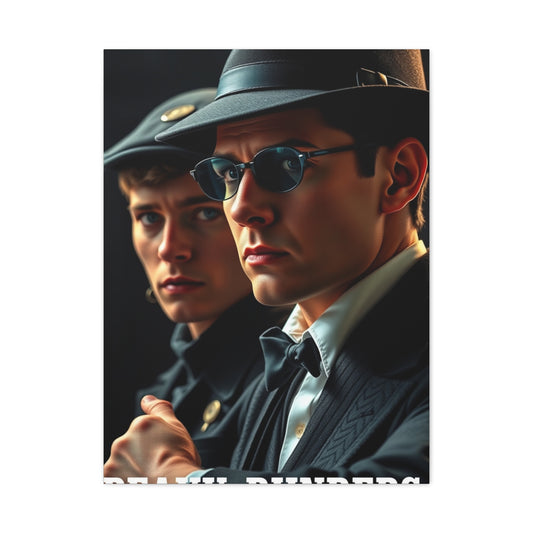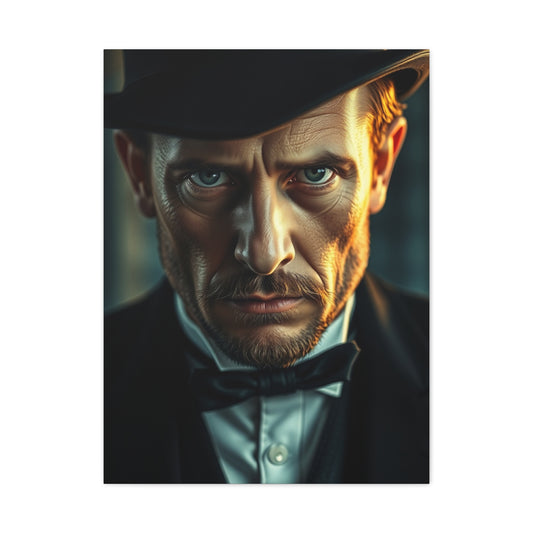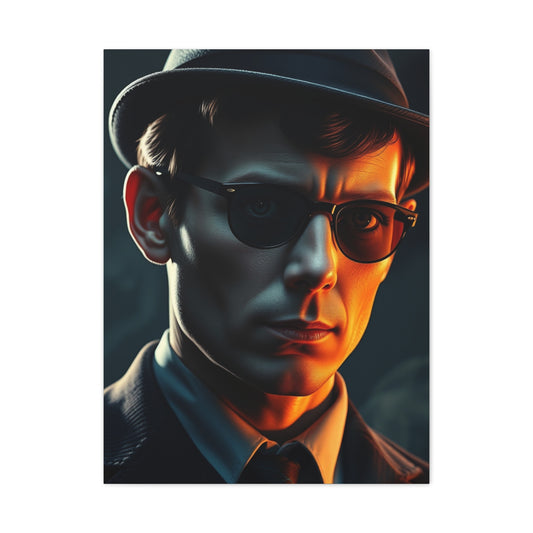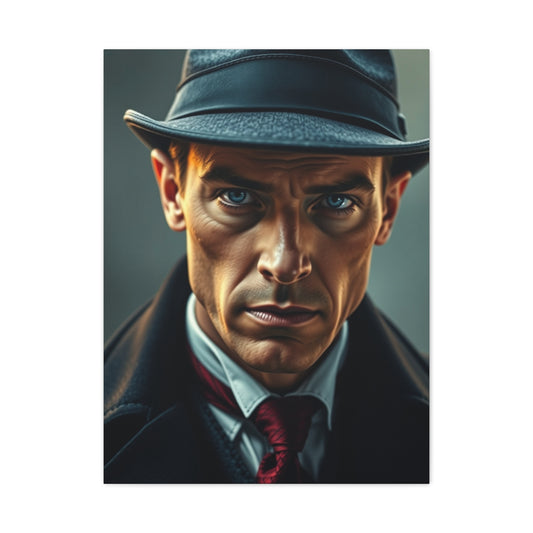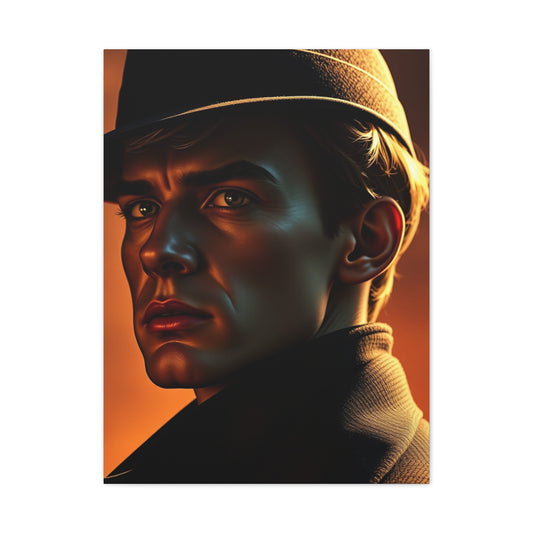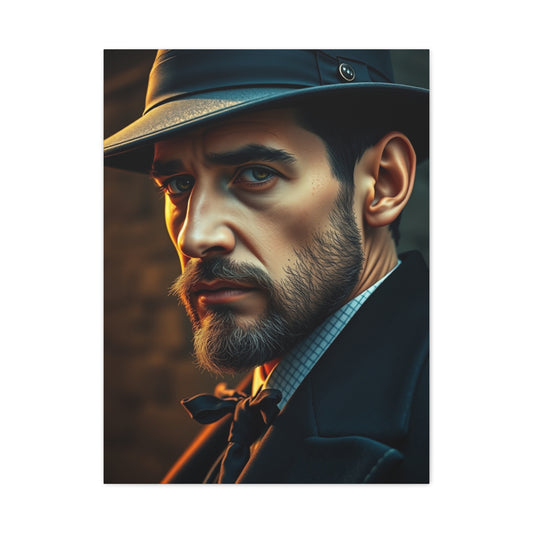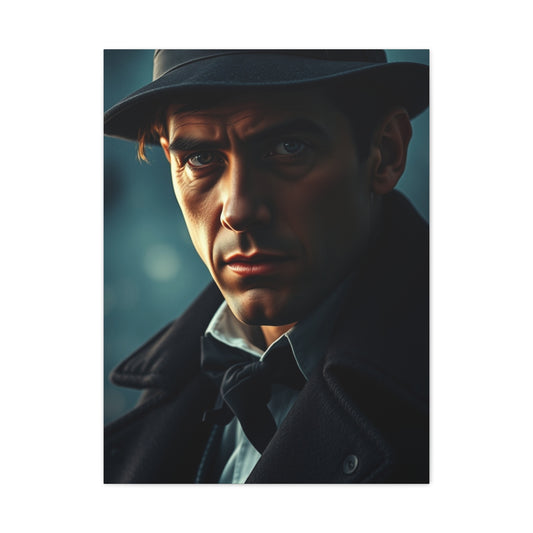Ultimate Collection to Peaky Blinders Wall Art: Transforming Your Space with Birmingham's Finest
The meteoric rise of Birmingham's most notorious family saga has transcended television screens, infiltrating contemporary home décor through an extraordinary array of visual masterpieces. This captivating crime drama, set against the gritty backdrop of post-World War I England, has spawned an entire industry of commemorative artwork that captures the essence of the Shelby clan's tumultuous journey through power, loyalty, and redemption.
The allure of these artistic representations extends far beyond mere fandom, tapping into a deeper appreciation for the show's distinctive visual aesthetics. The series' cinematography, characterized by its moody lighting, stark contrasts, and atmospheric smokiness, translates remarkably well into wall-mounted displays that serve as conversation starters and focal points within any room.
Contemporary collectors and enthusiasts have discovered that these pieces possess an inherent ability to transform ordinary spaces into sophisticated environments reminiscent of 1920s Birmingham. The artwork encompasses various styles, from photorealistic portraits of Thomas Shelby's piercing gaze to abstract interpretations of the show's recurring motifs, including razorblade caps, vintage automobiles, and the iconic Garrison Tavern.
The cultural impact of this phenomenon cannot be understated. What began as a British period drama has evolved into a global aesthetic movement, influencing everything from fashion choices to architectural preferences. The visual language established by the series has become synonymous with a particular brand of masculine sophistication, combining elements of working-class grit with upper-class refinement.
Artistic interpretations of the show's characters have emerged as powerful symbols representing various themes central to the human experience. Tommy Shelby's stoic determination, Arthur's volatile passion, Polly's unwavering strength, and Ada's rebellious spirit each offer different emotional resonances that viewers can incorporate into their personal spaces through carefully selected artwork.
The craftsmanship behind these pieces varies dramatically, from mass-produced prints suitable for casual fans to hand-painted canvases created by talented artists who have dedicated countless hours to capturing every nuance of their subjects' expressions. This diversity ensures that enthusiasts across all budget ranges can find suitable pieces to enhance their living environments.
The psychological appeal of displaying such artwork extends beyond simple decoration. These pieces serve as daily reminders of the values and characteristics that viewers admire in the show's protagonists. The determination to overcome adversity, the importance of family loyalty, and the courage to challenge established hierarchies are all themes that resonate with modern audiences seeking inspiration in their daily lives.
Character-Focused Artistic Representations
Thomas Shelby Portraits and Their Emotional Impact
The enigmatic leader of the Peaky Blinders commands attention in every artistic medium, with his penetrating stare and contemplative demeanor translating exceptionally well to canvas and paper. Artists worldwide have attempted to capture the complexity of Cillian Murphy's portrayal, focusing particularly on the character's eyes, which seem to hold centuries of wisdom and pain simultaneously.
Portrait styles range from hyperrealistic renditions that emphasize every facial line and shadow to stylized interpretations that highlight the character's most distinctive features. Many artists choose to incorporate symbolic elements alongside the portraits, such as cigarette smoke swirling around the subject or subtle background imagery depicting the industrial landscape of Birmingham.
The color palettes employed in these portraits often reflect the show's overall aesthetic, favoring muted tones, sepia effects, and dramatic contrasts between light and shadow. These choices create artwork that feels authentic to the series' visual identity while maintaining artistic merit independent of its source material.
Professional artists have noted the particular challenge of capturing Thomas Shelby's emotional complexity through static imagery. The character's ability to convey multiple layers of meaning through subtle facial expressions requires exceptional skill to translate into two-dimensional artwork. The most successful pieces manage to convey the character's intelligence, ruthlessness, and vulnerability simultaneously.
Arthur Shelby's Raw Energy in Visual Form
The eldest Shelby brother presents a fascinating subject for artistic interpretation, with his volatile temperament and passionate nature offering rich material for creative expression. Artists often emphasize Arthur's more explosive moments, capturing the intensity that Paul Anderson brings to the role through dynamic poses and aggressive brushwork.
These artistic representations frequently focus on the character's duality, contrasting his gentle, family-oriented nature with his capacity for extreme violence. Some pieces depict him in quiet moments of reflection, while others showcase his more dramatic confrontations, creating a comprehensive visual narrative of his character arc.
The physicality of Arthur Shelby translates well to various artistic mediums, from detailed pencil sketches that emphasize his weathered features to bold acrylic paintings that capture his kinetic energy. Artists often experiment with different techniques to convey the character's emotional volatility, using everything from aggressive brushstrokes to delicate shading to achieve their desired effects.
Color choices in Arthur-focused artwork tend toward warmer tones, reflecting his passionate nature and emotional intensity. Reds, oranges, and deep browns frequently appear in these pieces, creating visual warmth that contrasts with the cooler tones typically associated with other family members.
Polly Gray's Strength and Wisdom Through Art
The matriarch of the Shelby family provides artists with a compelling subject whose strength and complexity deserve careful attention to detail. Helen McCrory's powerful portrayal offers numerous visual elements that translate beautifully to artistic interpretation, from her character's distinctive fashion sense to her commanding presence.
Artistic representations of Polly often emphasize her role as the family's emotional anchor, depicting her in poses that convey authority and wisdom. Many artists choose to incorporate elements of mysticism and intuition into their work, reflecting the character's spiritual side and her ability to sense danger and opportunity.
The fashion elements associated with Polly's character provide additional opportunities for artistic expression. Her distinctive jewelry, elegant coats, and carefully styled hair offer visual details that can enhance the overall composition while remaining faithful to the character's established aesthetic.
Artists frequently experiment with different approaches when depicting Polly, ranging from formal portrait styles that emphasize her dignified bearing to more dynamic compositions that capture her in moments of action or emotional intensity. These varied approaches reflect the character's multifaceted nature and appeal to different artistic sensibilities.
John and Michael Shelby: Youth and Ambition Visualized
The younger generation of the Shelby family offers artists opportunities to explore themes of ambition, loyalty, and the costs of power. John Shelby's tragic arc and Michael Gray's complex relationship with the family provide rich material for emotional artistic expression.
Representations of John often emphasize his youthful energy and family devotion, capturing him in moments that highlight his role as both a loving father and a dangerous criminal. Artists frequently choose to depict him alongside family members, emphasizing the relationships that defined his character throughout the series.
Michael's artistic representations tend to focus on his evolution from innocent newcomer to corrupted family member. The visual contrast between his initial appearance and his later transformation provides compelling material for artists interested in exploring character development through sequential imagery.
The brotherhood between family members offers additional compositional possibilities, with group portraits and interaction scenes allowing artists to explore the complex dynamics that drive the show's narrative. These pieces often become conversation starters, inviting viewers to discuss their favorite character relationships and story moments.
Iconic Scenes and Memorable Moments in Art
The Red Right Hand Sequence Interpretations
The opening credits sequence of each episode provides a treasure trove of visual elements that artists have eagerly adopted for their creations. The silhouettes of figures walking through smoke-filled streets, the rhythmic editing, and the symbolic imagery all translate effectively to static artwork that captures the show's essential atmosphere.
Many artists create abstract interpretations of these opening moments, focusing on the mood and feeling rather than literal recreation. These pieces often feature dark silhouettes against industrial backgrounds, with strategic use of lighting and shadow to create dramatic visual impact.
The musical association with these scenes adds an additional layer of meaning to the artwork, as viewers often hear the iconic theme when viewing these pieces. This synesthetic response enhances the emotional impact of the artwork and creates stronger connections between the visual and auditory elements of the show.
Professional illustrators have noted the challenge of capturing the kinetic energy of the opening sequence in static form. Successful pieces often employ techniques borrowed from comic book art, using motion lines, dynamic poses, and strategic composition to suggest movement and energy within still images.
Garrison Tavern Atmosphere and Ambiance
The family pub serves as a central location throughout the series, providing artists with rich environmental details and atmospheric elements to incorporate into their work. The dim lighting, wooden fixtures, and period-appropriate decorations create a distinctive visual identity that resonates with viewers.
Artwork featuring the Garrison often emphasizes the contrast between the public face of the establishment and its role as the family's operational headquarters. Some pieces depict the tavern during busy evening hours, while others focus on quiet moments when family members conduct their more secretive business.
The architectural details of the pub provide excellent opportunities for artists interested in period accuracy and environmental storytelling. The careful recreation of fixtures, signage, and decorative elements demonstrates attention to detail that serious fans appreciate and value.
Color palettes in Garrison-focused artwork typically favor warm, amber tones that reflect the artificial lighting of the period. These choices create inviting, nostalgic atmospheres that make viewers feel as though they could step directly into the scene.
Birmingham Street Scenes and Industrial Landscapes
The show's setting provides a rich backdrop for artistic interpretation, with the industrial cityscape of 1920s Birmingham offering numerous visual elements that artists can incorporate into their work. The contrast between the grimy industrial areas and the more upscale districts reflects the social dynamics central to the show's themes.
Street scene artwork often captures the hustle and bustle of period life, depicting crowds of workers, street vendors, and the various characters who populate the Shelby family's world. These pieces provide context for the main characters while celebrating the rich supporting cast that brings the setting to life.
The industrial elements of Birmingham, including factories, smokestacks, and railway infrastructure, provide dramatic backdrops that emphasize the working-class origins of the Shelby family. Artists often use these elements symbolically, representing the foundation upon which the family's empire is built.
Weather effects, particularly fog and smoke, play important roles in many Birmingham-focused artworks. These atmospheric elements help create mood and provide visual continuity with the show's cinematographic style, ensuring that artwork maintains authentic connections to its source material.
Artistic Styles and Medium Variations
Photorealistic Approaches to Character Representation
Hyperrealistic artwork requires exceptional skill and patience, with artists spending dozens or even hundreds of hours perfecting every detail of their subjects. These pieces often become showpieces for both the artist's technical ability and the viewer's appreciation for craftsmanship.
The challenge of photorealistic Peaky Blinders artwork lies in capturing not just physical accuracy but also the emotional essence of the characters. Successful pieces manage to convey personality and inner life through subtle details in expression, posture, and environmental context.
Materials and techniques vary widely among photorealistic artists, with some preferring traditional mediums like graphite and charcoal while others embrace digital painting methods. Each approach offers unique advantages and challenges in achieving the desired level of realism.
The time investment required for photorealistic artwork often makes these pieces more expensive than other styles, but the resulting impact and conversation value justify the cost for serious collectors and dedicated fans.
Abstract and Impressionistic Interpretations
Abstract artwork inspired by the series focuses on emotional impact rather than literal representation, using color, form, and composition to evoke the feelings and themes associated with the show. These pieces often work better in modern décor schemes where photorealistic portraits might feel out of place.
Impressionistic approaches emphasize mood and atmosphere, using loose brushwork and strategic color choices to create pieces that capture the essence of characters or scenes without focusing on precise details. This style allows artists more creative freedom while maintaining recognizable connections to the source material.
Color symbolism plays important roles in abstract interpretations, with artists often developing personal visual languages that represent different characters or themes through specific hues and combinations. These systematic approaches create cohesive series of artworks that work well when displayed together.
The interpretive nature of abstract artwork encourages viewer engagement, as audiences must actively participate in understanding and appreciating the connections between the visual elements and their source material. This participation creates more meaningful relationships between viewers and artworks.
Pop Art and Contemporary Fusion Styles
Pop art interpretations of Peaky Blinders characters often incorporate bright colors, bold graphics, and commercial art techniques that create striking visual contrasts with the show's typically muted palette. These pieces appeal to viewers who appreciate contemporary artistic movements and want to incorporate modern aesthetics into their décor.
Contemporary fusion styles might combine elements of street art, graphic design, and traditional painting to create unique pieces that feel both contemporary and respectful of the source material. These approaches often appeal to younger audiences who appreciate artistic innovation and creative risk-taking.
Mixed media approaches allow artists to incorporate various materials and techniques into single pieces, creating complex artworks that reward close examination and repeated viewing. These pieces often become focal points in modern living spaces due to their visual complexity and artistic ambition.
The commercial appeal of pop art styles makes them popular choices for mass production, allowing more people to access high-quality artwork inspired by the series while supporting artists who work in these contemporary styles.
Vintage and Period-Appropriate Styling
Some artists choose to create artwork that appears as though it could have been produced during the 1920s, using period-appropriate techniques, materials, and aesthetic choices to create authentic-feeling pieces. This approach appeals to viewers who appreciate historical accuracy and want artwork that feels integrated with the show's temporal setting.
Sepia tones, aged paper effects, and vintage printing techniques help create artwork that feels historically authentic while depicting contemporary interpretations of the show's characters and themes. These pieces often work well in traditionally decorated spaces where modern artwork might feel anachronistic.
The research required for period-accurate artwork demonstrates artistic dedication and historical knowledge, qualities that serious collectors often value highly. These pieces serve educational purposes alongside their decorative functions, helping viewers understand the historical context that informs the show's visual identity.
Aging techniques applied to new artwork can create pieces that appear to be genuine period artifacts, adding mystery and authenticity to home décor while celebrating the show's careful attention to historical detail.
Size Considerations and Placement Strategies
Large-Scale Statement Pieces
Oversized artwork demands attention and creates dramatic focal points that can transform entire rooms. Large Peaky Blinders pieces work particularly well in spaces with high ceilings and ample wall space, where their impact can be fully appreciated without overwhelming other decorative elements.
The viewing distance required for large pieces means they work best in spaces where people can step back to appreciate the full composition. Living rooms, dining areas, and entrance halls often provide ideal locations for these impressive artworks.
Lighting considerations become more important with large pieces, as proper illumination can enhance their impact while poor lighting can diminish their effectiveness. Professional installation and lighting consultation may be worthwhile investments for particularly valuable or impressive pieces.
The cost of large-scale artwork often reflects both the increased materials required and the additional time investment needed to complete larger compositions. However, the visual impact and conversation value of these pieces often justify their higher prices.
Medium-Sized Versatile Options
Medium-sized pieces offer flexibility in placement while maintaining enough visual presence to serve as effective focal points. These artworks work well in various room configurations and can be repositioned as decorating needs change over time.
The most popular size range for home decorators balances visual impact with practical considerations, fitting well above furniture pieces, in hallway galleries, and as part of larger wall arrangements. This versatility makes medium pieces excellent choices for first-time buyers or those uncertain about their long-term decorating plans.
Framing options for medium-sized pieces provide opportunities to customize the overall presentation without overwhelming the artwork itself. The right frame can enhance the piece's connection to its source material or help it integrate better with existing décor.
Group arrangements of medium-sized pieces can create impressive gallery walls that tell visual stories or explore different artistic interpretations of similar themes. This approach allows collectors to build comprehensive displays over time while working within reasonable budget constraints.
Small Accent Pieces and Collection Building
Smaller artworks serve important roles in creating layered, interesting décor schemes, providing opportunities to incorporate favorite characters or scenes into spaces where larger pieces would be impractical. These pieces often work well in personal spaces like bedrooms, offices, or reading nooks.
The affordability of smaller pieces makes them excellent entry points for new collectors or gifts for friends and family members who appreciate the series. Building collections over time allows enthusiasts to explore different artistic styles and subjects without making major financial commitments.
Grouping strategies for small pieces can create impressive visual displays that rival single large artworks in impact. Careful planning of layouts, themes, and artistic styles helps ensure that collections feel cohesive rather than random or cluttered.
The intimate nature of small pieces allows for more personal connections with the artwork, as viewers can appreciate fine details and artistic techniques that might be lost in larger compositions. This quality makes them particularly suitable for spaces where people spend extended periods in close proximity to the walls.
Color Schemes and Home Décor Coordination
Monochromatic and Sepia-Toned Options
Black and white artwork offers timeless elegance that coordinates well with various decorating styles while maintaining strong connections to the show's visual aesthetic. The high contrast between light and dark elements creates dramatic impact without competing with colorful décor elements.
Sepia-toned pieces provide warmth and vintage appeal that works particularly well in traditionally decorated spaces or rooms with earth-tone color schemes. The nostalgic quality of sepia effects helps reinforce the historical setting of the series while creating inviting, comfortable atmospheres.
Monochromatic artwork offers flexibility in framing and matting choices, as neutral tones coordinate with various frame materials and colors. This flexibility allows buyers to customize the presentation to match their existing décor without compromising the artwork's integrity.
The sophistication of monochromatic pieces appeals to viewers who prefer subtle décor elements that enhance rather than dominate their living spaces. These pieces work well in professional settings where bold colors might be inappropriate or distracting.
Rich Earth Tones and Industrial Aesthetics
The muted color palette associated with industrial Birmingham translates well to home décor, with browns, grays, and muted greens creating sophisticated color schemes that feel both contemporary and historically grounded. These colors work particularly well in spaces with exposed brick, concrete, or metal architectural elements.
Rust and copper tones reflect the industrial heritage central to the show's setting, providing warm accent colors that prevent earth-tone schemes from feeling cold or unwelcoming. These colors coordinate well with leather furniture, wooden fixtures, and metal accessories.
The authenticity of industrial color schemes appeals to viewers who appreciate the show's historical accuracy and want their décor to reflect similar attention to period detail. This approach creates immersive environments that feel connected to the series' world.
Layering different earth tones creates visual depth and interest while maintaining cohesive color schemes that feel intentional rather than accidental. This sophistication appeals to decorators who want their spaces to feel professionally designed.
Bold Accent Colors and Modern Interpretations
Contemporary interpretations of Peaky Blinders artwork sometimes incorporate bright accent colors that create striking contrasts with the show's typically muted palette. These pieces work well in modern spaces where traditional colors might feel too subdued or historically distant.
Strategic use of bold colors can highlight specific elements within artworks while maintaining overall respect for the source material's aesthetic identity. This approach allows artists to express their personal vision while remaining faithful to the series' established visual language.
The energy of bold colors appeals to younger audiences who appreciate contemporary artistic approaches and want their décor to reflect current design trends. These pieces can serve as bridges between traditional period aesthetics and modern decorating sensibilities.
Color coordination with existing décor becomes more challenging with bold accent pieces, but the potential visual impact often justifies the additional planning required to create successful room designs. Professional decorating advice may be helpful for incorporating these pieces effectively.
Framing and Presentation Excellence
Period-Appropriate Frame Selections
Authentic 1920s frame styles help artwork feel integrated with its historical source material, creating presentations that appear as though they could have existed during the show's temporal setting. These frames often feature ornate details, rich finishes, and substantial construction that reflects the craftsmanship values of the era.
The weight and presence of period frames can enhance the perceived value and importance of artwork while demonstrating the owner's attention to historical detail. These presentations often become conversation starters that allow hosts to discuss both the artwork and their appreciation for historical accuracy.
Antique and reproduction frame options provide different approaches to achieving period authenticity, with genuine antique frames offering unique character and patina while reproductions provide consistent quality and availability. The choice between these options often depends on budget considerations and personal preferences regarding authenticity.
Professional frame restoration services can help ensure that antique frames remain in excellent condition while providing safe, archival mounting for valuable artwork. This investment protects both the frame and the artwork while maintaining historical integrity.
Contemporary Minimalist Approaches
Clean, simple frame designs allow artwork to speak for itself without competing decorative elements drawing attention away from the image. This approach works particularly well with photorealistic pieces where artistic technique deserves primary focus.
The versatility of minimalist frames makes them excellent choices for buyers who might want to reposition artwork in different rooms or adjust their decorating schemes over time. Simple frames coordinate with various design styles without looking out of place.
Material choices for minimalist frames, including metal, simple wood profiles, and even frameless mounting options, provide different aesthetic effects while maintaining the clean, uncluttered appearance that defines this approach. Each material offers unique advantages in terms of durability, cost, and visual impact.
The cost effectiveness of simple frames allows more budget to be allocated to artwork itself, making this approach popular among collectors who prioritize artistic quality over presentation elaboration. This philosophy aligns well with the straightforward, no-nonsense attitude often associated with the Shelby family characters.
Museum-Quality Preservation Methods
Archival materials and conservation-grade techniques ensure that valuable artwork remains in excellent condition for decades, protecting investments while maintaining visual quality. These methods are particularly important for limited edition pieces or original artworks that may increase in value over time.
UV-filtering glazing protects artwork from sun damage that can cause fading and deterioration, while acid-free backing materials prevent chemical reactions that could damage paper or canvas over time. These preservation techniques demonstrate serious commitment to artwork care and protection.
Climate control considerations become important for valuable pieces, as temperature and humidity fluctuations can cause expansion and contraction that damages both artwork and frames. Professional conservation advice helps ensure that preservation efforts are appropriate for specific pieces and environmental conditions.
The investment in museum-quality presentation often pays dividends in terms of artwork longevity and resale value, making these methods particularly important for serious collectors who view their purchases as long-term investments rather than temporary decorations.
Collectible Value and Investment Potential
Limited Edition Significance and Rarity
Numbered limited editions create scarcity that often drives increased value over time, particularly when produced by well-known artists or authorized by the show's creators. The combination of limited availability and growing fan base creates market conditions favorable to value appreciation.
Certificate authenticity provides documentation that supports resale value while protecting buyers from fraudulent reproductions. Serious collectors should insist on proper documentation for any limited edition purchases, particularly those involving significant financial investments.
The reputation of publishing houses, galleries, and artists significantly impacts the long-term value potential of limited edition pieces. Established names in entertainment artwork often provide better investment security than unknown producers, even when initial costs are higher.
Market tracking services and auction results provide insights into value trends for entertainment-related artwork, helping collectors make informed decisions about purchases and sales. This research becomes particularly important for buyers considering artwork as investment vehicles rather than purely decorative purchases.
Artist Recognition and Career Development
Emerging artists who create impressive Peaky Blinders artwork may experience career growth that increases the value of their early pieces. Identifying talented artists before they achieve widespread recognition can provide both aesthetic satisfaction and financial benefits for prescient collectors.
Social media presence and online engagement metrics provide indicators of artist popularity and career trajectory, helping collectors identify promising talents whose work may appreciate significantly over time. These modern tools supplement traditional gallery representation in assessing artist potential.
Exhibition history and critical recognition demonstrate professional acknowledgment of artist talent and commitment to their craft. Pieces by artists with museum exhibitions, critical reviews, or professional awards often carry premium values justified by objective quality assessments.
The specialization in entertainment artwork requires different skills than traditional fine art, with successful artists demonstrating both technical ability and deep understanding of their source material. This specialization can create niche markets where talented artists command premium prices from dedicated collectors.
Market Trends and Value Appreciation
The sustained popularity of the series creates ongoing demand for related artwork, supporting stable or increasing values for quality pieces. Unlike artwork based on short-lived entertainment phenomena, Peaky Blinders' cultural impact suggests long-term market viability.
International audience growth expands the potential collector base, creating global markets for artwork that might previously have appealed only to regional audiences. This expansion provides additional price support and liquidity for sellers in the secondary market.
Quality differentiation becomes increasingly important as the market matures, with superior craftsmanship and artistic vision commanding premium prices while mass-produced items face price pressure from continued production. This trend rewards collectors who prioritize quality over quantity.
The development of specialized auction houses and online marketplaces provides improved liquidity for entertainment artwork, making it easier for collectors to buy and sell pieces while establishing transparent price discovery mechanisms that benefit all market participants.
Sourcing Authentic and Quality Pieces
Reputable Artist Platforms and Galleries
Professional galleries that specialize in entertainment artwork often provide quality assurance and authenticity guarantees that protect buyers from fraudulent or substandard pieces. These establishments typically maintain relationships with established artists and can provide valuable guidance about artistic merit and investment potential.
Online platforms have democratized access to artwork while creating challenges in quality assessment and authenticity verification. Successful buyers develop skills in evaluating artist credentials, artwork quality, and seller reliability through online channels.
Artist workshops and studio visits provide opportunities to meet creators personally while observing their working methods and artistic philosophy. These experiences often enhance appreciation for finished pieces while providing confidence in authenticity and quality.
Commission opportunities allow collectors to obtain personalized pieces that meet specific requirements regarding size, subject matter, and artistic style. This approach often provides better value than purchasing completed works while ensuring perfect fit with decorating needs.
Avoiding Counterfeit and Low-Quality Options
Mass-production warning signs include inconsistent print quality, poor color reproduction, and substandard materials that indicate commercial reproduction rather than artistic creation. Buyers should develop skills in recognizing these indicators to avoid disappointment with their purchases.
Price comparison research helps establish market ranges for different types of artwork, allowing buyers to identify suspiciously low prices that might indicate quality problems or authenticity issues. Exceptionally cheap pieces often prove to be poor investments due to quality limitations.
Return policies and satisfaction guarantees provide protection for buyers who discover quality problems after purchase. Reputable sellers typically offer reasonable return periods and clear policies that demonstrate confidence in their merchandise quality.
Professional installation services can identify quality problems that become apparent only during mounting and display processes. These services often provide valuable feedback about artwork condition and presentation options that enhance long-term satisfaction.
Creating Gallery Walls and Series Displays
Thematic Grouping Strategies
Character-focused collections that feature different artistic interpretations of single personalities create cohesive displays that reward careful viewing while telling visual stories about character development and artistic variety. These arrangements work particularly well in spaces dedicated to entertainment or relaxation.
Scene-based groupings that recreate memorable moments through multiple artistic perspectives provide comprehensive explorations of pivotal story elements. These displays often become conversation centers where viewers can discuss favorite episodes and character interactions.
Artistic style progressions that move from realistic to abstract interpretations of similar subjects demonstrate the range of creative approaches possible with single source material. These educational displays appeal to viewers interested in artistic process and creative development.
Color-coordinated arrangements that group pieces based on palette similarities create visually harmonious displays that work well in rooms with specific decorating themes. This approach prioritizes aesthetic unity while maintaining thematic connections to source material.
Spatial Arrangement and Visual Flow
Height variations create visual interest while ensuring comfortable viewing angles for different pieces within collections. Strategic placement of larger pieces at eye level with smaller accents above and below creates balanced arrangements that feel professionally designed.
Spacing calculations must account for both individual piece requirements and group composition effectiveness. Proper spacing allows each piece to be appreciated individually while contributing to overall group impact and visual coherence.
Viewing sequence considerations guide visitor attention through collections in logical progressions that enhance understanding and appreciation. Thoughtful arrangement creates narrative flow that makes gallery walls more engaging and memorable.
Balance principles ensure that visual weight distributes evenly across displays, preventing any single area from overwhelming others while maintaining overall harmony. Professional arrangement techniques help achieve sophisticated results that justify the investment in multiple pieces.
Expansion Planning and Future Additions
Growth accommodation requires planning display spaces that can incorporate additional pieces without compromising existing arrangements. Flexible mounting systems and expandable layouts provide options for collection development over time.
Theme consistency ensures that future additions will integrate successfully with existing collections while providing guidelines for acquisition decisions. Establishing clear collecting criteria helps maintain focus and coherence as collections grow.
Quality maintenance standards prevent collection dilution through inferior additions while ensuring that expansion enhances rather than diminishes overall impact. Consistent quality criteria protect investment value while maintaining aesthetic standards.
Budget planning for collection growth helps ensure sustainable acquisition practices while providing clear guidelines for purchase decisions. Understanding long-term collecting goals helps prioritize purchases and avoid impulsive decisions that might compromise overall collection quality.
Customization and Commissioning Options
Personal Photograph Integration
Custom artwork that incorporates personal photographs with Peaky Blinders themes creates unique pieces that celebrate both the series and individual memories. These pieces often become treasured keepsakes that combine entertainment appreciation with personal significance.
Digital manipulation techniques allow skilled artists to integrate personal images seamlessly with series-inspired backgrounds, creating convincing and attractive compositions that appear professionally produced. These services require careful artist selection to ensure satisfactory results.
Style matching ensures that personal elements integrate naturally with Peaky Blinders aesthetic elements, creating cohesive pieces that honor both sources of inspiration. Professional artists understand how to balance these requirements while maintaining artistic integrity.
Family group possibilities extend personal integration concepts to include multiple individuals in series-inspired settings. These pieces often become unique gifts that celebrate shared entertainment interests while documenting family relationships.
Specific Scene Recreation
Favorite moment reproduction allows fans to commission artwork depicting their most beloved series scenes with personalized elements or artistic interpretations. These pieces provide permanent reminders of emotional high points from the viewing experience.
Artistic license opportunities encourage creative interpretation while maintaining recognizable connections to source material. Collaborative processes between commissioner and artist often produce results that exceed initial expectations through creative exploration.
Detail specification services ensure that commissioned pieces include particular elements that hold special significance for buyers. Clear communication about requirements and expectations helps ensure satisfactory results while respecting artistic vision.
Revision processes provide opportunities to refine commissioned works until they meet buyer expectations while respecting artist expertise and creative contributions. Professional commissioning relationships balance client needs with artistic integrity.
Size and Medium Flexibility
Custom dimensions ensure perfect fit with specific display spaces while maintaining proper proportions and visual impact. Professional artists understand how to adapt compositions for different sizes without compromising artistic effectiveness.
Material selection provides options that match room requirements, maintenance preferences, and budget considerations while ensuring appropriate artistic quality. Different mediums offer various advantages in terms of durability, appearance, and cost.
Finish options including glossy, matte, and textured surfaces create different visual effects that can enhance integration with room décor or personal preferences. Understanding these options helps ensure satisfaction with final results.
Timeline coordination ensures that commissioned pieces arrive when needed while allowing sufficient time for quality execution. Professional artists provide realistic schedules that balance quality requirements with delivery expectations.
Conclusion:
The fascination with Peaky Blinders extends far beyond its gripping narrative and complex characters—it has evolved into a cultural and artistic phenomenon. As viewers delve into the world of the Shelbys, they often find themselves drawn not only to the drama and intrigue but also to the show’s distinctive visual style and the emotional depth of its characters. Through wall art, fans have found a powerful medium to keep the spirit of Birmingham’s most infamous family alive in their own homes, transforming living spaces into personalized tributes to this iconic series.
At its core, the Peaky Blinders wall art movement is about more than mere decoration. It’s a celebration of identity, values, and storytelling. Each piece—whether it’s a detailed portrait of Tommy Shelby or an abstract depiction of the Garrison Tavern—invites the viewer to revisit pivotal moments, themes, and emotions from the show. It transforms blank walls into curated experiences, where every glance at a canvas serves as a reminder of ambition, resilience, and the cost of power.
The diversity within this art collection mirrors the multifaceted nature of the show itself. With styles ranging from gritty realism to imaginative abstraction, there's something for every kind of admirer. Whether you gravitate towards Thomas Shelby’s cool intellect, Arthur’s emotional volatility, or Polly’s fierce independence, the right artwork can reflect and reinforce the aspects of the series that resonate most personally. In this way, Peaky Blinders art becomes not just a homage but a mirror—an emotional connection between viewer, character, and self.
Furthermore, this artistic movement provides an opportunity for creators to explore their own interpretations of the show’s characters and themes. Artists bring their unique perspectives and techniques to each piece, adding new layers of meaning and offering fresh visual narratives that stand independently while paying respect to the source material. This creative dialogue between fan and artist enhances the cultural footprint of the show and ensures its legacy endures through innovative visual storytelling.
For interior decorators and homeowners, integrating Peaky Blinders artwork is also a strategic aesthetic choice. The show’s moody palettes, vintage stylings, and industrial influences align perfectly with popular design trends such as dark academia, rustic elegance, and steampunk-inspired interiors. These artworks effortlessly elevate a room’s atmosphere, providing depth, texture, and a sense of cinematic drama that few other décor choices can replicate.
In the end, the ultimate collection of Peaky Blinders wall art is more than a gathering of images—it’s a curated experience that pays tribute to a series that captured the imagination of millions. It offers a way to extend the story beyond the screen, allowing fans to immerse themselves in the drama, emotion, and aesthetic of the Shelbys every day. Whether displayed in a living room, office, or private study, these pieces serve as lasting reminders of a story well told—and of characters who, in all their flawed humanity, continue to inspire.


